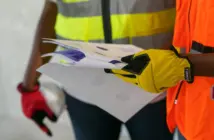Rebecca and Nathan Keoghan are the fifth generation of Nathan’s family to farm their land seven km from Westport.
They value that strong heritage – but previous careers in different sectors have ensured a modern perspective on health and safety.
“We moved here in 2006,” said Rebecca.
“Before that, Nathan was managing a forestry company and doing his MBA.
“I have a medical science degree and had managed laboratories in New Zealand, Australia and London, so we both have high awareness around health and safety.”
Rebecca then also spent several years as Operations Manager of Holcim’s Westport plant and now combines her job as business manager for seven Landcorp dairy units with relief milking duties at Keoghan Farm.
However, she says the changes they have put into place are straightforward measures any farm could adopt.
Rebecca and Nathan bought the 300 hectare farm from his parents in 2012.
They milk 210 Jersey cows off 85 Ha with a 40Ha drying platform.
They have one part-time staff member and are also rearing 50 Jersey heifers and calves.
The rest of the land is laid out to native planting, some radiata and swamp pakihi.
“Every contractor who comes onto the farm has a full induction and, on every visit, we also go through the hazards of the day.”
Measures they have introduced include full inductions and policies around contractors on the farm, monthly team meetings, effective signage at all entrances, an incident management programme, working alone policy and thorough risk assessment and programme of work to install guards in the milking shed.
They are also in the process of replacing quad bikes with side-by-sides.
“They sign in when they arrive and let us know in person or by text when they leave.
“Most are very experienced in working in industry as well as agriculture and understand the importance of risk awareness.
“We have had a contractor injured on the farm.
“We have three steps up to the vat and one is a short step and he fell and hurt his hip, requiring some time off work.
“He recovered but his employer did a very good investigation and we did an internal one.
“As a result of the findings from those, we have added a second handrail, so there is a rail on both sides and we’ve add signage warning about the short step.”
“We have a very simple risk matrix to define the levels of risk.”
Signs at the farm’s three entry-points outline major hazards, specify speed limits and the requirement to look out for children, and rules such as wearing helmets if using quads.
It includes Nathan’s phone number and stipulates visitors must contact him before entering the property.
The incident management programme sees all near misses, actual incidents, risks and hazards noted down as they happen or are observed, and then entered into an electronic spreadsheet.
“We have a very simple risk matrix to define the levels of risk,” says Rebecca.
“We look at each and use that to define whether the risk was low, medium or high – high being potential for serious harm or fatality.”
They are replacing quads for two reasons: safety and efficiency.
“Often the two go hand in hand,” says Rebecca.
“We had three and are just in the process of replacing the last one. We also make sure everyone has their own personal protective equipment so they don’t have to share.
“To start with, it was a challenge to get our staff members to even wear their helmets.
“But once we talked about what we’re doing around health and safety and why, they totally came on board.
“Wearing PPE is just part and parcel of what they do now along with keeping Nathan updated by text as part of our working alone policy.”
Last year they carried out a risk assessment on their milking shed – resulting in a significant safety upgrade.
“Doing that made us realise it was very high risk. It had unguarded areas with both risks for trips, slips and falls, including from sides of stairways, and unguarded machinery.
“Nathan worked with a local contractor to put in guarding – there was a lot of welding.
“We now have guarding on rails, ramps and moving belts, addressing the risk of falls or getting hands caught.
“The children aren’t allowed in the shed but you need to remove that risk, just in case.
“Health and safety has been a journey for us, it still is. Now we need to plan Nathan’s next project.”
WorkSafe Sector Leader for Agriculture Al McCone says that the Keoghan farm highlights the essentials of good health and safety practice.
“They have conducted thorough risk analyses and are working to eliminate the risks.
“To do this, they are involving and communicating with the people who live and work on the farm.”
Worker engagement and participation
The best outcomes are achieved when a business and its workers work together on health and safety.
Worker Engagement and Participation is about having planned ways for:
- workers to give input on issues which will (or are likely to) affect their health or safety. This includes asking for and taking into account their views and
- workers to improve work health and safety on an ongoing basis (eg by raising concerns or suggesting improvements).
This will help you and your business to make better decisions – and keep your people and productivity thriving.
Key points
Empowering workers to speak up means they can:
- share their frontline knowledge
- contribute to decision-making process
- raise their health and safety concerns.
For more examples and information visit worksafe.govt.nz


